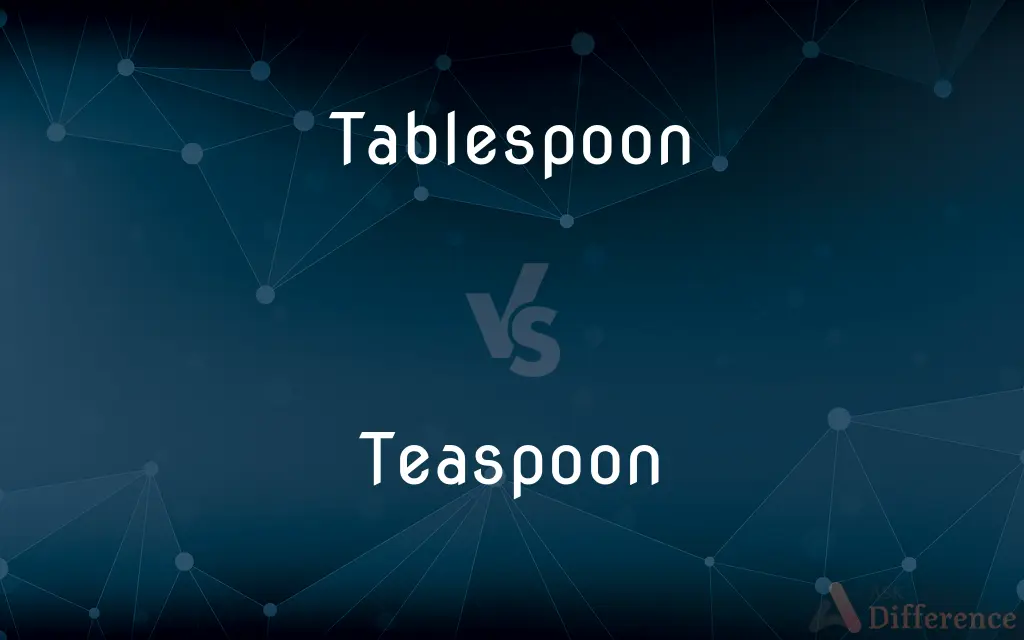Tablespoon vs. Teaspoon — What's the Difference?
Edited by Tayyaba Rehman — By Fiza Rafique — Updated on September 22, 2023
A tablespoon is a unit of measure in cooking, typically equal to three teaspoons or 15 milliliters. A teaspoon is a smaller unit of measure, usually equal to about 5 milliliters.

Difference Between Tablespoon and Teaspoon
Table of Contents
ADVERTISEMENT
Key Differences
Both tablespoon and teaspoon are units of measurement commonly used in cooking and baking. A tablespoon is the larger of the two, typically equivalent to three teaspoons. In the United States, a tablespoon is approximately 14.8 milliliters, while a teaspoon holds about 4.93 milliliters. These measurements may vary slightly in other countries but the ratio generally remains the same: one tablespoon is equal to three teaspoons.
The abbreviations for tablespoon and teaspoon are "Tbsp" and "tsp," respectively. While these abbreviations are standardized, it's crucial to note the difference to avoid culinary mishaps. Confusing tablespoons with teaspoons in a recipe can significantly alter the outcome, as the former is three times larger than the latter.
Tablespoons and teaspoons are not just used for measuring liquids; they can also be used for dry ingredients like spices, sugar, and salt. It's generally advisable to use measuring spoons for both tablespoon and teaspoon measurements, rather than ordinary household spoons, to ensure accuracy.
While the primary function of tablespoons and teaspoons is to measure ingredients, they are also used as eating utensils. Tablespoons are commonly used for eating foods like soups and cereals, while teaspoons are often used for stirring beverages like tea or coffee. However, the eating utensils are not as standardized in volume as measuring spoons and should not be used for accurate measurements in recipes.
Comparison Chart
Volume
About 15 milliliters
About 5 milliliters
ADVERTISEMENT
Abbreviation
Tbsp
Tsp
Use in Recipes
Larger quantities
Smaller quantities
Number of Teaspoons
1 tablespoon = 3 teaspoons
1 teaspoon = 1/3 tablespoon
Common Use as Utensil
Soups, cereals
Stirring drinks
Compare with Definitions
Tablespoon
A tablespoon is three times the volume of a teaspoon.
This recipe requires one tablespoon of sugar, not a teaspoon.
Teaspoon
"tsp" is the standard abbreviation for teaspoon.
The recipe calls for 1 tsp of cinnamon.
Tablespoon
"Tbsp" is the standard abbreviation for tablespoon.
The ingredients list reads 2 Tbsp of milk.
Teaspoon
Teaspoons are used for measuring smaller quantities in cooking and baking.
Use a teaspoon for adding spices to the mix.
Tablespoon
A tablespoon is a unit of measure equal to 15 milliliters.
Add two tablespoons of olive oil to the pan.
Teaspoon
A teaspoon is a unit of measure equal to about 5 milliliters.
Add a teaspoon of vanilla extract for flavor.
Tablespoon
Tablespoons are commonly used for measuring both dry and liquid ingredients.
Use a tablespoon to scoop out the flour.
Teaspoon
A teaspoon is one-third the volume of a tablespoon.
This recipe needs just a teaspoon of salt.
Tablespoon
A tablespoon is a large spoon. In many English-speaking regions, the term now refers to a large spoon used for serving; however, in some regions, it is the largest type of spoon used for eating.
Teaspoon
A teaspoon (tsp.) is an item of cutlery. It is a small spoon that can be used to stir a cup of tea or coffee, or as a tool for measuring volume.
Tablespoon
A large spoon for serving food.
Teaspoon
The common small spoon used especially in serving and consuming tea, coffee, and desserts.
Tablespoon
Abbr. T or tbs. or tbsp. A household cooking measure equal to 3 teaspoons, or 1/2 fluid ounce (15 milliliters). See Table at measurement.
Teaspoon
Abbr. t or tsp. A household cooking measure equal to 1/3 tablespoon (about 5 milliliters). See Table at measurement.
Tablespoon
A large spoon, used for eating food from a bowl.
Teaspoon
A small spoon used to stir the contents of a cup or glass.
Tablespoon
A spoon too large for eating, usually used for cooking or serving.
Teaspoon
A unit of measure, equivalent to one-third of a tablespoon or roughly five milliliters.
Tablespoon
(cooking) A unit of volume, the value of which varies regionally; in the US: three teaspoons or one half fluid ounce or roughly 15 ml; in Britain and Canada: exactly 15 ml; in Russia 18 ml; in Australia: four teaspoons or 20 ml.
Teaspoon
To serve with a teaspoon
I teaspooned some sugar into my cup.
Tablespoon
A spoon of the largest size commonly used at the table; - distinguished from teaspoon, dessert spoon, etc.
Teaspoon
A small spoon used in stirring and sipping tea, coffee, etc., and for other purposes.
Tablespoon
As much as a tablespoon will hold
Teaspoon
Same as teaspoonful.
Tablespoon
A spoon larger than a dessert spoon; used for serving
Teaspoon
A small spoon used for stirring tea or coffee; holds about one fluid dram
Tablespoon
Tablespoons are also eating utensils commonly used for soups and cereals.
She took a tablespoon from the drawer to eat her soup.
Teaspoon
As much as a teaspoon will hold
Teaspoon
Teaspoons are commonly used for stirring beverages like tea and coffee.
He stirred his coffee with a teaspoon.
Common Curiosities
How do I abbreviate tablespoon and teaspoon?
"Tbsp" is the abbreviation for tablespoon, and "tsp" is for teaspoon.
What is a tablespoon?
A tablespoon is a unit of measure used in cooking, typically equal to 15 milliliters or three teaspoons.
What is a teaspoon?
A teaspoon is a smaller unit of measure used in cooking, usually about 5 milliliters.
Are tablespoon measurements the same worldwide?
Generally, no. The volume can differ slightly between countries.
What is the most common use of a tablespoon as an eating utensil?
It is commonly used for eating soups and cereals.
Can I use eating utensils as measuring spoons?
It's not advisable as they are not as standardized as measuring spoons.
How many teaspoons are in a tablespoon?
There are generally three teaspoons in a tablespoon.
Can I use a tablespoon and teaspoon interchangeably in recipes?
No, a tablespoon is three times larger than a teaspoon, so they are not interchangeable.
What's the main difference between a tablespoon and teaspoon?
The primary difference is in volume; a tablespoon is three times larger than a teaspoon.
Should I level off a tablespoon or teaspoon when measuring?
For accurate measurements, leveling off is generally recommended.
Are tablespoons and teaspoons used only for liquids?
No, they can be used for both dry and liquid ingredients.
What is the most common use of a teaspoon as an eating utensil?
It is commonly used for stirring beverages like tea and coffee.
Can tablespoons and teaspoons be made from different materials?
Yes, they can be made from plastic, metal, or wood.
What should I do if I don't have a tablespoon or teaspoon for measuring?
You can use other measurement tools, but ensure you convert the measurements accurately.
Is it crucial to use the correct measurement?
Yes, using the wrong measurement can significantly affect the outcome of a recipe.
Share Your Discovery

Previous Comparison
Cuttlefish vs. Squid
Next Comparison
Puckish vs. PukishAuthor Spotlight
Written by
Fiza RafiqueFiza Rafique is a skilled content writer at AskDifference.com, where she meticulously refines and enhances written pieces. Drawing from her vast editorial expertise, Fiza ensures clarity, accuracy, and precision in every article. Passionate about language, she continually seeks to elevate the quality of content for readers worldwide.
Edited by
Tayyaba RehmanTayyaba Rehman is a distinguished writer, currently serving as a primary contributor to askdifference.com. As a researcher in semantics and etymology, Tayyaba's passion for the complexity of languages and their distinctions has found a perfect home on the platform. Tayyaba delves into the intricacies of language, distinguishing between commonly confused words and phrases, thereby providing clarity for readers worldwide.














































